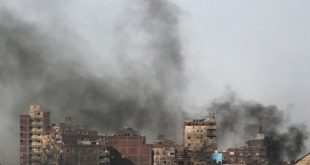Egypt Independent
“An unprecedented fuel spill that has polluted huge stretches of Arctic rivers was caused by melting permafrost”, Russian officials said Friday, “ordering a review of infrastructure in vulnerable zones”.
The spill has coloured remote tundra waterways with bright red patches visible from space. This highlights the danger of climate change for Russia as areas locked by permafrost for centuries thaw amid warmer temperatures.
News of the cause of the accident came amid a huge clean-up effort outside the Arctic city of Norilsk, which President Vladimir Putin said, “should be bankrolled by metals giant Norilsk Nickel”.
A National-level state of emergency was announced after 21,000 tonnes of diesel fuel spilled from a reservoir that collapsed last Friday.
Norilsk Nickel owns the reservoir through a subsidiary.
Three criminal probes have been launched, and Russia’s prosecutor general’s office said, in a statement, that “preliminary findings indicate sagging ground as the reason for the disaster”.
Norilsk, one of the country’s biggest industrial centres, lies above the Arctic circle and Norilsk Nickel had already said, “it suspects permafrost thawing”. It attempted to control the spill for two todays, before calling for specialists.
Other factors may be at play too: the country’s technical safety watchdog told TASS news agency that, “since 2016, it has been unable to check the condition of the 35-year-old reservoir, because the company said it was under repairs”.
Speaking with officials at the site by video call, Putin told Norilsk Nickel chief Vladimir Potanin, he “expected the company to pay for a comprehensive clean-up”.
“It’s necessary to carry out all the compensatory measures to restore biodiversity and the environment”, he said.
Potanin estimated that the operations “would cost about 10 Billion rubles ($146 Million), on top of any fines”.
“We will spend whatever is needed,” said Potanin. “We will return the ecosystem back to normal”.
The Ambarnaya River, which is affected by the spill, feeds into Lake Pyasino, a major body of water and the source of the Pyasina River that is vitally important to the entire Taimyr peninsula.
Satellite images, released by the European Space Agency and Russia’s Roscosmos, show a large spot of reddish fuel had travelled over 20 kilometres (12 miles) toward the lake from the spill site.
Russia’s fisheries agency and some environmentalists said that the floating barriers erected on the river by responders are unable to stop the majority of the pollution, which can quickly dissolve or sink.
“The spill also polluted 180,000 square meters of land before reaching the river”, regional prosecutors said.






